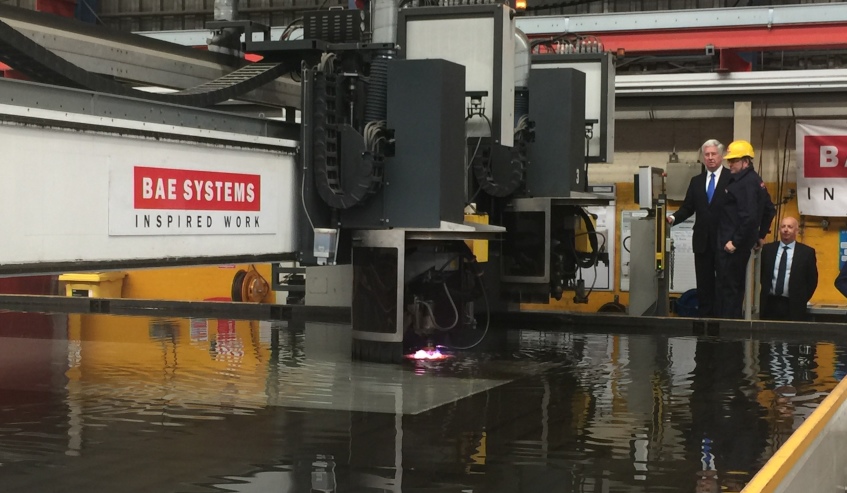The Royal Navy marked a major milestone in the development of its surface fleet on Thursday with the commencement of manufacture of its Type 26 Global Combat Ship.
The BAE Systems-built Type 26 will partially replace the Royal Navy’s Type 23 anti-submarine variant frigates, with the first three Type 26s approved for construction by the UK Ministry of Defence as part of a £3.7 billion ($6 billion) contract.
The Type 26 Global Combat Ship is one of three solutions being considered by the Australian government as part of the SEA 5000 Future Frigate Program, which will see the replacement of the eight ageing Anzac Class Frigates with nine high-capability warships.
A ‘steel cutting ceremony’ held at BAE Systems Govan Shipyard facility in Glasgow, Scotland, has kick-started a decades-long program for the construction and sustainment of the Royal Navy’s Type 26 frigate.
The Type 26 program will support more than 4,000 jobs across BAE Systems and its UK maritime supply program, with the first ship to be delivered to the Royal Navy in the mid-2020s.
Sir Michael Fallon, Secretary of State for Defence, said the commencement of the manufacturing phase of the Type 26 GCS was a milestone for the Royal Navy, Scottish shipbuilding and UK Defence more widely.
"[The new ship] will protect our powerful new aircraft carriers and nuclear deterrent, keeping British interests safe across the world," Sir Michael said.
"The Type 26 is a cutting-edge warship that will maintain our naval power with a truly global reach. Designed for a service life of at least 25 years, the Type 26 will form a backbone of the future Royal Navy surface fleet into the 2060s.”
The new frigates will strengthen the Royal Navy’s anti-submarine warfare (ASW) capabilities across multiple areas of deployment, including the North Atlantic, the Mediterranean and the Arabian Gulf.
According to ASW authority Captain Tim Green RN, the Type 26 is a world-class solution that will not only protect UK strategic assets including the new Queen Elizabeth Class carriers and support operational objectives, it will also sustain and protect national and industrial capability.
Purpose-built for ASW, the Type 26 offers an acoustically quiet hull form, centred on maintaining noise hygiene, and propeller design combined with Sonar 2087 and 2050 to prosecute submarines supported by a Merlin Mk2 helicopter – elements that will give the ship considerable war fighting advantages, according the Capt. Green.
Iain Stevenson, managing director of BAE Systems Naval Ships, said the steel cutting ceremony was a proud day for its employees and the wider UK maritime supply chain.
"Providing our customers with next generation platforms and technologies that give them an essential edge is what inspires us," he said.
"Working with the Ministry of Defence and the Royal Navy we have designed the Type 26 in a fully digital environment and have now seen her through the eyes of her crew in a 3D environment. Through this approach we have a mature ship design that is ready for manufacture."
In a rapidly changing Asia-Pacific security environment, the Australian government requirement for the SEA 5000 Future Frigate Program dictates for the new frigates to have capabilities spanning anti-air and anti-surface warfare, but with a major focus on anti-submarine warfare.
It is expected that by 2035 half of the world’s advanced submarines and combat aircraft will be based in the Asia-Pacific region, with at least 76 submarines alone operated by North Korea and 68 by China, according to Royal Navy sources.
The total cost of the SEA 5000 program is planned at $30 billion.
BAE Systems’ Type 26 Global Combat Ship is joined by Italy’s Fincantieri and Spanish firm Navantia as part of the competitive tender to secure the SEA 5000 ship build contract, with request for tender documents expected to be lodged by the three businesses in August for consideration and assessment.
The manufacture of the new frigates is set to commence in 2020.
Fincantieri has proposed a multi-mission frigate, or FREMM, and Navantia a redesigned F-100 as part of their tender bids.








